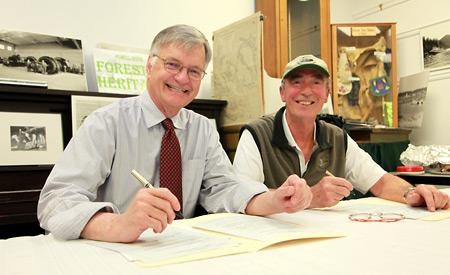Powell River’s forestry and historical museums have gone from separate history to unified future.
After months of consultations, the boards of directors of both societies have merged the functions of Powell River Forestry Museum Society (PRFMS) with Powell River Historical Museum and Archives (PRHMA).
At a signing ceremony to consolidate the two museum societies on Tuesday, May 27, Lee Coulter, president of the historical museum, and Dave Florence, president of the forestry museum, signed papers, and on September 14, 2014, the two societies will officially become one entity.
“We are very pleased to turn over the forestry museum collection to the PRHMA to own and manage for the community,” said Florence. “We are confident their trained professional staff and volunteers will bring improvements to the collection for the benefit of the community and tourists.
“Under our new name of Powell River Forestry Heritage Society, we will support the PRHMA as it manages the collection, and carry on our work on the Willingdon Beach Trail and the Paradise Valley Railroad.”
Bert Finnamore, heritage manager of PRHMA, said he was very pleased with the outcome of the talks between the two museums.
“The forestry museum has a significant collection and exhibit that complements those housed at the historical museum,” he said. “We are looking forward to working with the new forestry heritage society and developing new displays that will use our combined strengths to greater advantage.”
The forestry museum is housed in the old Willingdon Beach bathhouse. It provides about 200 square metres of static displays. The museum is open to the public between 12:30 and 4:30 pm during July and August.
PRFMS manages Willingdon Beach Trail and deploys and maintains logging artifacts along the trail.
The society also maintains the miniature railway at Paradise Exhibition Park with about 290 metres of track, and one-fifth scale rolling stock, including a gas locomotive, caboose and several ride cars.
The historical museum leases two buildings, containing about 660 square metres, from the City of Powell River. The Centennial Building houses collections of 125,000 images, 800 maps and blueprints, about 7,000 objects and about 500 specimens.
The museum display facility next door houses 260 square metres of exhibits depicting Coast Salish First Nation culture, the Powell River Company mill, forestry, life in the community, military, notable people and many other small presentations.
Finnamore said he came to the historical museum almost a year ago and noticed almost immediately the “competition across the street.” Florence invited him to one of the forestry museum’s board meetings, provided a tour and Finnamore was “very impressed.
“We began talking about the mutual interests we have,” he said. Finally, he came right out and said: “Would you be interested in consolidation talks?”
Finnamore said the exhibits are wonderfully done, and the collection fits very well with the historical museum’s small forestry exhibit.
“Between us, the museums have incredible resources,” he added. “What’s really exciting is that these resources are going to be brought together into what I think will be a wonderful partnership.”
Finnamore said a valuable component of reaching the consolidation agreement is the imperative to have continued partnership between the two societies.
“The museum community in Powell River is in a position now to speak with a single voice,” he said. “We know we need a renewed space. We have to develop that proposal and take it to the city, the province and federal government. This agreement really provisions us to speak with one voice, and that I truly prize.”
Florence said his biggest trigger for amalgamation was thinking into the future when a new space is required.
“We know with two organizations we would have been looking after our own interests,” he said.



